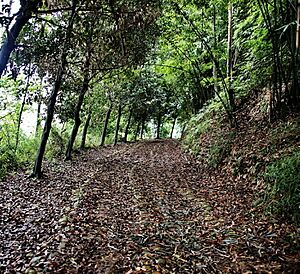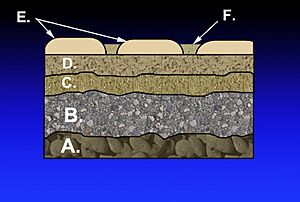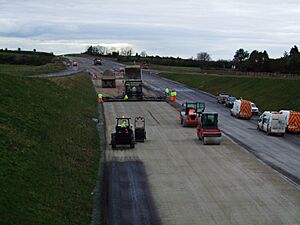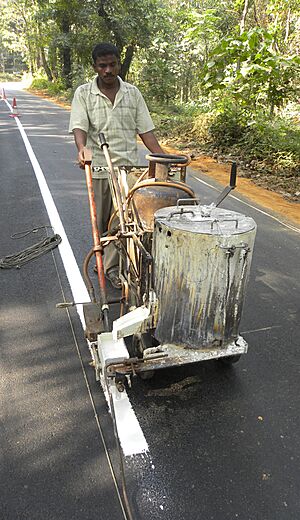Road facts for kids
A road is a special path built for vehicles and people to travel on. Unlike streets, which are often public spaces in towns, roads are mainly for getting from one place to another.
There are many kinds of roads, like parkways (often in parks), avenues (wide streets, often with trees), and controlled-access highways (like freeways or motorways where you can only get on and off at certain points). Other types include tollways (where you pay to use them), interstates, and local roads.
Roads usually have important parts like lanes for vehicles, sidewalks (or pavements) for walking, medians (strips of land separating traffic), shoulders (the side of the road), and paths for bikes or shared use.
Contents
What is a Road?
Long ago, many roads were just paths people used without much building or upkeep.
Today, different groups define a road in slightly different ways:
- The OECD says a road is a way for public traffic, mainly for motor vehicles, using a stable surface that isn't rails or air strips. This includes bridges and tunnels, but not bike paths.
- The Eurostat, ITF, and UNECE define a road as a path open to public traffic, mostly for motor vehicles, with a stable base. This includes paved roads, gravel roads, streets, bridges, and tunnels. It does not include special bike lanes.
- The 1968 Vienna Convention on Road Traffic says a road is the whole surface of any way or street open to public traffic.
In cities, roads might go through a town or village and be called streets. Modern roads are usually smooth and paved to make travel easy.
Road Definitions Around the World
Different countries have their own ways of defining roads:
- In Australia, a road is an area open to the public, used mainly for driving or riding motor vehicles. It also includes shoulders and areas for cyclists or parking.
- In New Zealand, the idea of a road is very wide. It can include beaches, public car parks, river beds, and bridges, even if they are privately owned, as long as the public can access them.
- In the United Kingdom, the term "road" often means any public path, including footpaths, bridleways (for horses), and cycle tracks. It can also include private driveways and car parks if the public can use them.
- In the United States, laws separate "public roads" (open to everyone) from "private roads" (controlled by private owners).
History of Roads
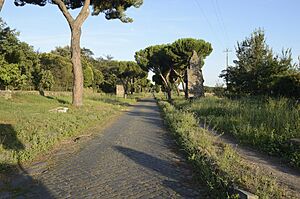
People have been using paths for travel for a very long time, possibly even following animal trails. By about 10,000 BC, humans were using rough paths.
- The world's oldest known paved road was built in Egypt between 2600 and 2200 BC.
- Corduroy roads (made of logs) have been found from 4000 BC in England.
- The Sweet Track in England, built around 3807 BC, is one of the oldest engineered timber paths found in Northern Europe.
- Around 500 BC, Darius I the Great of Persia started building a huge road system, including the famous Royal Road.
- In ancient times, traveling by river was often easier and faster than by road because boats could carry much more than carts.
- From about 312 BC, the Roman Empire built strong, straight stone roads across Europe and North Africa to help their armies move. At its peak, the Roman Empire had about 78,000 kilometers (48,000 miles) of paved roads.
- In the 8th century AD, the Arab Empire built many roads, with some in Baghdad even paved with tar from petroleum.
- In Britain, the turnpike trusts started around 1706. These groups built good roads and collected tolls (fees) from travelers to pay for them.
- In the late 1800s, engineers began building separate lanes for cyclists next to roadways.
- In the 1900s, roads were increasingly built for tourism and to create jobs.
- The AVUS road in Berlin, Germany, opened in 1921, was the first road built only for automobiles.
- The Autostrada dei Laghi in Italy, opened in 1924, was the world's first controlled-access highway. It connected Milan to lakes and had one lane in each direction without interchanges.
How Roads are Built
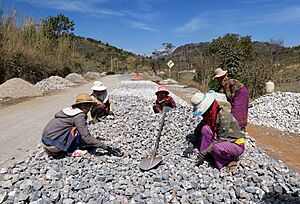
Building a road is a big engineering project. It involves creating a continuous path, getting around natural obstacles like hills, and making sure the slopes are gentle enough for vehicles and walkers.
The process often starts by clearing land, digging or blasting away earth and rock, and building embankments, bridges, and tunnels. Then, the paving material is laid down. Many types of road building equipment are used.
Engineers carefully plan the road's path, including curves and slopes, to fit the natural land and reduce how much earth needs to be moved.
Roads are designed for cars, trucks, and pedestrians. Managing storm water and protecting the environment are very important. Drainage systems are built to carry rainwater away from the road safely.
Materials like gravel and rock are often needed for construction. These are usually found in nearby "borrow pits." The top layer of soil (topsoil) is removed from these pits and saved to help the land recover later.
Before building, old road surfaces, fences, and buildings might need to be removed. Trees in the area might be protected and kept clear of construction. Topsoil from the road path is usually saved to help new embankments grow plants later. Stumps and roots are removed, and holes are filled. After the road is built, the area is replanted and watered to look natural again.
During earthwork, workers dig, remove extra material, fill in low areas, and compact the ground. If bad material like soft rock is found, it's removed and replaced with good fill material that is compacted tightly. When a low area needs to be filled, the native ground is compacted first. Then, layers of fill material are spread and compacted until the road reaches the right height.
Good fill material should be free of plants and have certain strength qualities. The lower layers of fill often contain sand or fine gravel, which helps prevent plants from growing and allows water to drain. The roadbed must be "proof rolled," meaning a heavy roller passes over it without causing dents, to show it's compacted correctly.
Special materials like geotextiles (fabric-like materials) are often used in road layers to make the road stronger and last longer. These materials help separate layers, reinforce the ground, filter water, and improve drainage. They can reduce building costs and maintenance.
Finally, the road is paved or left as a gravel surface, depending on how it will be used and the cost. Safety features like traffic signs, crash barriers, and road markings are then added.
Driving on rough roads can cost drivers money due to vehicle wear, more maintenance, and extra fuel.
When a single road is made into a dual carriageway (two separate roads for opposite directions), it's called "duplication" or "twinning." The old road becomes one-way, and a new road is built for traffic going the other way.
Changing How Roads are Used
Sometimes, roads built for one type of transport can be changed for another. For example, in city centers, some roads meant for cars are now being used more for cycling and walking. This is often done using traffic signs.
Road Maintenance
Like all structures, roads wear out over time. This happens because of weather (like frost and heat) and the constant use by vehicles. Very heavy vehicles cause much more damage to roads than light cars. Potholes are often caused by rain and vehicle braking.
Roads are designed to last a certain number of years, called their "service life." For example, some new roads are designed to last 40 years. Maintenance is planned throughout this time. If a road lasts much longer, it might have been overbuilt, costing too much initially. If it fails too soon, repairs will be expensive. Some asphalt roads are designed to be "perpetual pavements," meant to last over 50 years.
Most roads need some kind of maintenance before they reach the end of their life. Road agencies check road conditions regularly and do "preventive maintenance" to make roads last longer. This can involve using special equipment to measure the road's surface.
Common maintenance for asphalt roads includes adding thin layers of asphalt, sealing cracks, and applying surface treatments. These treatments help protect the road and extend its life.
Older concrete roads can be repaired by adding "dowel bars" at joints, which helps the slabs stay together. This can add 15 years to the road's life.
Not taking care of roads can be very costly for society. Poor road conditions lead to more vehicle repairs, higher fuel use, and faster tire wear for drivers.
Fixing Concrete Roads
Sometimes, concrete roads lose support underneath because of empty spaces (voids). These voids can form near cracks or joints when water seeps in. "Slab stabilization" is a way to fix this without breaking the road. It involves pumping a special mixture (like cement or polyurethane) through small holes drilled in the slab. This mixture fills the voids and helps keep water out.
This method helps restore support to the concrete slabs, making them stronger. It's usually done along with other repairs like patching.
Sealing Joints and Cracks
Another maintenance method is "joint sealing," which means filling cracks and joints in the road. This stops water and dirt from getting in and helps prevent corrosion of the metal bars inside concrete roads. The process involves removing old sealant, cleaning the joint, putting in a "backer rod," and then adding new sealant. Different materials like hot tar or silicone can be used for the sealant.
Road Safety
Careful design and building of roads can make them much safer and reduce accidents, injuries, and property damage.
On local roads, things like traffic calming (to slow down cars), safety barriers, pedestrian crossings, and cycle lanes help protect everyone.
Some roads have special markers like "Cat's eyes" or "Botts dots" to help drivers see the lanes, especially at night or in bad weather.
For major roads, safety can be improved by:
- Having limited access (fewer entry/exit points).
- Using grade separated junctions (overpasses or underpasses) so roads don't cross at the same level.
- Having median dividers between traffic going in opposite directions to prevent head-on crashes.
Safety devices like guardrails, wide grassy areas, and sand barrels are also common. Road signs and light poles are often designed to break easily if a car hits them, to reduce harm. Removing large trees close to the road can also make it safer. During heavy rains, roads need to be built higher than the surrounding land to prevent flooding.
Speed limits are also very important for road safety, as they help reduce the number of accidents and injuries. The WHO says controlling speed is one of the best ways to make roads safer.
Road Conditions
Road conditions describe how easy or hard it is to drive on a road. This includes the quality of the surface, if there are potholes, how clear the road markings are, and the weather. Bad road conditions, especially combined with weather, are a main cause of traffic accidents.
Many government groups and news services report on road conditions to help drivers know about any dangers in an area, like snow or ice.
Environmental Impact of Roads
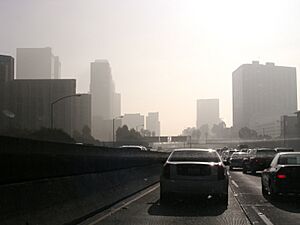
Roads can affect the environment, but careful design can reduce these negative impacts.
- Water Pollution: Rain and snowmelt running off roads can pick up gasoline, oil, metals, and trash, leading to water pollution.
- De-icing Chemicals: Salt and other chemicals used to melt ice can run off into the ground and water, harming plants and animals. Sand used on icy roads can turn into fine dust, causing air pollution.
- Noise Pollution: Roads are a big source of noise. Noise barriers can be built near homes to reduce this.
- Air Pollution: Vehicles on roads release pollutants into the air. Air pollution is often higher near roads. Road dust can also cause allergies. Also, emissions from vehicles are a major cause of climate change.
Road Rules: Driving on the Right or Left
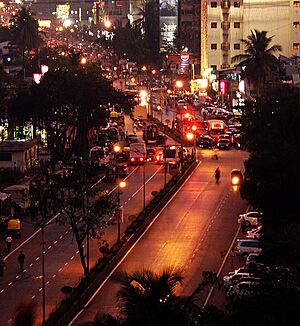
Traffic flows on either the right or the left side of the road, depending on the country.
- In countries where traffic drives on the right, signs are usually on the right, and roundabouts go counter-clockwise. Pedestrians should look left first when crossing.
- In countries where traffic drives on the left, the opposite is true.
About 33% of the world's people drive on the left, while 67% drive on the right. Most traffic originally drove on the left worldwide.
Roads and Money
Transport economics studies how transport systems, like roads, affect the economy. Roads are usually built and maintained by governments using taxes, though sometimes private companies build and operate toll roads.
Sometimes, governments work with private companies to build and maintain roads. This helps share the costs.
Society relies heavily on good roads. In the EU, almost half of all goods are moved by trucks on roads, and most people travel by car, bus, or coach on roads.
How Much Does it Cost to Build Roads?
Building multi-lane roads can be very expensive. For example, in the northeastern United States, some highways built in the mid-1900s cost millions of dollars per mile.
Road Statistics Around the World
The United States has the largest road network in the world, with over 4 million miles of roads as of 2009. India has the second largest, followed by China and Brazil. When looking only at expressways (major highways), China has a very large network, second only to the United States.
Connecting the World by Road
Most continents like Eurasia, Africa, North America, South America, and Australia have huge road networks that connect most cities.
- The road networks of North and South America are separated by the Darién Gap, a wild area with no roads.
- Eurasia and Africa are connected by roads through the Sinai Peninsula.
- The European Peninsula is connected to the Scandinavian Peninsula by bridges like the Øresund Bridge.
- Antarctica has very few roads and no continent-wide network, though there are some ice roads between research bases.
- Bahrain is a rare example of an island country connected to a continent by a road bridge (the King Fahd Causeway to Saudi Arabia).
Many islands close to mainlands are connected by bridges, like the Overseas Highway in Florida that connects many of the Florida Keys.
Some places, even on mainlands, have no roads connecting them to the main network because of mountains, wetlands, or high costs. Unpaved roads are common in developing countries and can become unusable in wet weather.
For islands or disconnected places, if many people want to travel there by car, special roll-on/roll-off ferries are often available. For longer trips, people usually fly and rent a car. Vehicles and cargo can also be shipped by boat or air. The island of Great Britain is connected to Europe by the Eurotunnel Shuttle, a train that carries cars under the sea.
In very cold polar areas, disconnected places are sometimes easier to reach by snowmobile or dogsled when the water freezes. Roads do reach into some of these areas, like the Dalton Highway in Alaska. However, large parts of Alaska, Canada, Greenland, and Siberia have very few roads. For example, all 25 communities in Nunavut, Canada, are disconnected from each other and the main road network.
Road travel can also be stopped by border controls and travel rules between countries. For example, traveling from other parts of Asia to South Korea by road would mean going through North Korea, which is difficult.
Some places are intentionally car-free, meaning cars are not allowed, and roads (if they exist) are only for bikes or pedestrians.
New roads are always being built to connect more remote places. Engineers are even thinking about huge projects like a bridge or tunnel across the Bering Strait to connect Eurasia-Africa and North America, or a bridge across the Strait of Gibraltar to connect Europe and Africa directly.
See also
 In Spanish: Carretera para niños
In Spanish: Carretera para niños
- Glossary of road transport terms
- Highway engineering
- List of countries by road network size
- List of roads and highways
- Road transport
- Trade route


